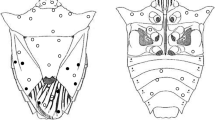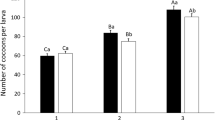Abstract
Figs (Ficus) are keystone resources that maintain tropical biodiversity. Pollinators, non-pollinating fig wasps, and some insects that feed internally in syconia (the fruits of figs) synchronize their developmental stages with syconia. Other insects feed and develop externally on the syconia but little is known about adaptations in these insects. We investigated the life cycle of Elasmucha necopinata, a bug that develops externally on the syconia of Ficus hispida, a functionally dioecious fig. The bug oviposits about a week after fig receptivity, the nymphs feed externally on the syconia and eclosion occurs when the syconia mature. Thus, nymphs synchronize their developmental stages with the male syconia of F. hispida. Although the relationship does not appear to be mutualistic, we suggest that E. necopinata, feeding externally, has adapted to figs, in a similar way to Agaonid fig wasps that live internally. We believe that this is the first direct evidence of adaptation of an externally feeding insect to figs.
Similar content being viewed by others
References
Anstett MC, Hossaert-McKey M, Kjellberg F (1997) Figs and fig pollinators: evolutionary conflicts in a coevolved mutualism. Trends in Ecology & Evolution 12:94–99
Bai LF, Yang DR, Compton SG (2008) A gall midge inhabiting the figs of Ficus benjamina in Xishuangbanna, south-western China. Symbiosis 45:149–152
Basset Y, Novotny V, Weiblen GD (1997) Ficus: a resource for arthropods in the tropics, with particular reference to New Guinea. In: Watt AD, Stork NE, Hunter MD (eds) Forest and Insects. Springer, New York, pp 342–361
Bronstein JL (1988) Predators of fig wasps. Biotropica 20:215–219
Compton SG, Disney RHL (1991) New species of Megaselia (Diptera: Phoridae) whose larvae live in fig syconia (Urticales: Moraceae), and adults prey on fig wasps (Hymenoptera: Agaonidae). Journal of Natural History 25:203–219
Cook JM, Rasplus J-Y (2003) Mutualists with attitude: coevolving fig wasps and figs. Trends in Ecology & Evolution 18:241–248
Hamilton WD (1979) Wingless and fighting males in fig wasps and other insects. In: Blum MS, Blum NA (eds) Reproductive Competition, Mate Choice and Sexual Selection in Insects. Academic Press, New York, pp 167–220
Harry M, Solignac M, Lachaise D (1996) Adaptive radiation in the Afrotropical region of the Paleotropical genus Lissocephala (Drosophilidae) on the pantropical genus Ficus (Moraceae). Journal of Biogeography 23:543–552
Hawkins BA, Compton SG (1992) African fig wasp communities: undersaturation and latitudinal gradients in species richness. Journal of Animal Ecology 61:361–372
Herre EA (1999) Laws governing species interactions? Encouragement and caution from figs and their associates. In: Keller L (ed) Levels of Selection in Evolution. Princeton University Press, Princeton, NY, pp 209–237
Jousselin E, Rasplus J-Y, Kjellberg F (2003) Convergence and coevolution in a mutualism: evidence from a molecular phylogeny of Ficus. Evolution 57:1255–1269
Kerdelhue C, Rossi J-P, Rasplus J-Y (2000) Comparative community ecology studies on old world figs and fig wasps. Ecology 81:2832–2849
Lachaise D (1977) Niche separation of African Lissocephala within the Ficus Drosophilid community. Oecologia 31:201–214
Lachaise D, McEvey SF (1990) Independent evolution of the same set of characters in fig flies (Lissocephala, Drosophilidae). Evolutionary Ecology 4:358–364
Lachaise D, Tsacas L, Couturier G (1982) The Drosophilidae associated with tropical African figs. Evolution 36:141–151
Machado CA, Herre EA, McCafferty SS, Bermingham E (1996) Molecular phylogenies of fig pollination and nonpollinating wasps and the implications for the origin and evolution of the fig-fig wasp mutualism. Journal of Biogeography 23:531–542
Machado CA, Jousselin E, Kjellberg F, Compton SG, Herre EA (2001) Phylogenetic relationships, historical biogeography and character evolution of fig-pollinating wasps. Proceedings of the Royal Society B-Biological Sciences 268:685–694
Machado CA, Robbins N, Gilbert MTP, Herre EA (2005) Critical review of host specificity and its coevolutionary implications in the fig/fig-wasp mutualism. Proceedings of the National Academy of Sciences 102:6558–6565
Marussich WA, Machado CA (2007) Host-specificity and coevolution among pollinating and nonpollinating New World fig wasps. Molecular Ecology 16:1925–1946
Patel A, Anstett MC, Hossaert-McKey M, Kjellberg F (1995) Pollinators entering female dioecious figs: why commit suicide? Journal of Evolutionary Biology 8:301–313
Perrin H (1992) Biosystematic and ecological evolution of Curculio (Coleoptera: Curculionidae) double radiation on Ficus and on Fagales. Bulletin de la Société Zoologique de France 117:105–108
Proffit M, Schatz B, Bessiere JM, Chen C, Soler C, Hossaert-McKey M (2008) Signalling receptivity: comparison of the emission of volatile compounds by figs of Ficus hispida before, during and after the phase of receptivity to pollinators. Symbiosis 45:15–24
Rasplus J-Y, Harry M, Perrin H, Chassagnard M-T, Lachaise D (2003) The Ficus (Moraceae) and fig entomofauna (Hym. Agaonidae, Pteromalidae, Torymidae, Eurytomidae; Dipt. Drosophilidae; Col. Curculionidae) of Mount Nimba in Guinea. Memoires du Museum National d'Histoire Naturelle 190:107–182
Roskam JC, Nadel H (1990) Redescription and immature stages of Ficiomyia perarticulata (Diptera: Cecidomyiidae), a gall midge inhabiting syconia of Ficus citrifolia. Proceedings of the Entomological Society of Washington 92:778–792
Shanahan M, So S, Compton SG, Corlett R (2001) Figeating by vertebrate frugivores: a global review. Biological Reviews of the Cambridge Philosophical Society 76:529–572
Song Q, Yang D, Zhang G, Yang C (2001) Volatiles from Ficus hispida and their attractiveness to fig wasps. Journal of Chemical Ecology 27:1929–1942
Sugiura S, Yamazaki K (2004) Moths boring into Ficus syconia on Iriomote Island, south-western Japan. Entomological Science 7:113–118
Verkerke W (1989) Structure and function of the fig. Experientia 45:612–622
Weiblen GD (2002) How to be a fig wasp. Annual Review of Entomology 47:299–330
Author information
Authors and Affiliations
Corresponding author
Rights and permissions
About this article
Cite this article
Ma, GC., Hu, HY., Niu, LM. et al. Adaptation of the externally feeding bug Elasmucha necopinata (Hemiptera: Acanthosomatidae) to its fig host. Symbiosis 49, 133–136 (2009). https://doi.org/10.1007/s13199-009-0048-4
Received:
Accepted:
Published:
Issue Date:
DOI: https://doi.org/10.1007/s13199-009-0048-4




